- Did Savarkar inspire
freedom fighters like Bhagat Singh, Khudiram Bose, Netaji Bose? Why did
Savarkar want Hindus to join the Indian Army?
With the release of the Veer Savarkar
movie trailer in early 2023 Netaji Bose grandnephew slammed actor Randeep Hooda
for distorting history. Source The
movie is said to be released shortly.
On the relations between the two freedom
fighters C Ghose wrote in ThePrint, “New information shows that not only was the relation between Bose and Savarkar much more nuanced, but they also held each other in high regard despite their political differences. Bose issued a statement welcoming the return of Savarkar to public life on the latter’s release from jail in 1937. He hoped that Savarkar would join the Congress. By the end of the year, however, Savarkar had joined the Hindu Mahasabha.
Surprisingly, in spite
of his political differences, Bose entered into an electoral alliance with the
Hindu Mahasabha for the Calcutta Municipal Corporation in March 1940. The
alliance, however, did not last long and was terminated even before the
elections were held, embittering the relations between Bose and the Mahasabha,
led by Syama Prasad Mookerjee in Bengal.
Incidentally, much before the electoral alliance was in the realm of possibility and when Bose was still critical of Savarkar’s politics, the 30 December 1939 issue of the Forward Bloc published an article by S. Krishna Iyer mourned the loss of Savarkar to a sectarian ideology. However, it had astonishingly high praise for the person that he was. Savarkar too, showed admiration and appreciation for Bose wherever he referred to him publicly.
About a month after the latter left India, Savarkar sent a message to the organisers of the All-India Subhas day, observed on 23 February 1941, expressing anxiety for his safety.”
Hooda’s May 2023 tweet, “The most wanted Indian by the British. The inspiration behind revolutionaries like-Netaji Subhash Chandra Bose, Bhagat Singh & Khudiram Bose.”
This Mint report quotes Bose’s family denying that Savarkar inspired freedom fighters. “Netaji was against Hindu Mahasabha. He had a more inclusive and secular ideology. If the movie presents distorted facts, the nation's 140 crore people will go against him (Hooda),” Chandra Bose said.
The questions are did Savarkar inspire freedom fighters
including Bose and Bhagat Singh. Why did Savarkar want Hindus to join the
Indian Army?
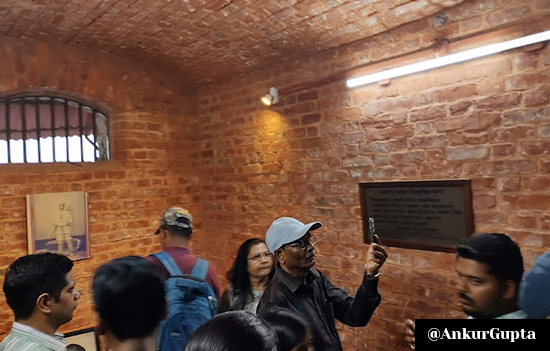 Solitary Cell in Cellular Jail, Andamans where Savarkar was confined.
Solitary Cell in Cellular Jail, Andamans where Savarkar was confined.
So I decided to re-read
the biography on Savarkar by Dhanajay Keer (awarded Padma Bhushan in 1971) and Thoughts on Pakistan written by Dr
Ambedkar in 1941. Keer wrote the biography in 1950, long before current
controversies and a second edition in 1966.
All credit to authors
and publisher. I have quoted excerpts from these books.
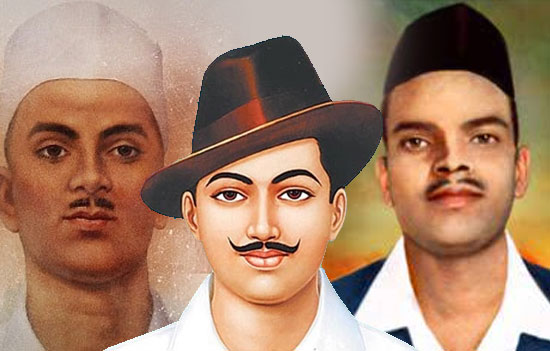 Centre Bhagat Singh, left Sukhdev and right Rajguru.
Centre Bhagat Singh, left Sukhdev and right Rajguru.
Savarkar wrote in
Marathi in April 1908-The First Indian
War of Independence 1857. The book inspired the second war of Independence
in 1914. Bhagat Singh and his colleagues brought out an underground edition of
the book in 1928 to feed the flames of revolution and finance their Party. 1 Pg. 69
Did Savarkar
book influence the 3rd war of Independence under the leadership of
Netaji Bose in 1943?
Seems so. “The names of the battalions and divisions, songs and slogan, spirit and inspiration of the Indian National Army were derived from this holy book of Savarkar. K F Nariman wrote in, “The Savarkar Special Number” of Free
Hindustan Weekly, Bombay: “The idea of I.NA. and particularly the Rani Jhansi regiment seem to have originated from Savarkar’s proscribed publication on the great 1857 Revolution and Mutiny.? 1 Pg. 69
Post his release from jail, Savarkar’s house in Ratnagiri was raided. Bhagat Singh had printed 2,000 copies of that famous book to raise money for his revolutionary society and had sent the first two copies of the book to Savarkar hence the raid. 1 Pg. 217
Mr Fenner Brockway, the
Political Secretary of the Independent Labour Party of England, gave 3 reasons for the transfer of the power by Britain
to India, one of which was revolt in the Royal Indian Navy. Although he
did not directly mention the I.NA., it was clear that the revolt in the armed
forces had bent them to the inevitable. Who had worked towards carrying the fire of patriotism into the ranks of the
Indian Army ever since 1908? It was Savarkar alone. 1 Pg. 484
“At last the destined leader, Netaji Bose, seized the opportunity and reaped the fruits of the pioneering efforts of Ras Behari Bose and militarization policy of Savarkar.” 1 Pg. 484
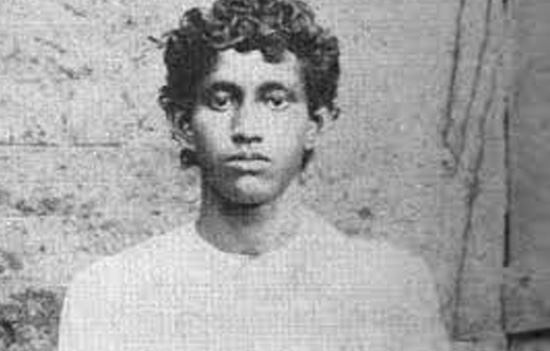 Khudiram Bose, 18 year old revolutionary.
Khudiram Bose, 18 year old revolutionary.
P M Bapat, Hotital
Verma and H Das reached India in March 1908 and circulated copies of the BOMB Manual through important centres of the
revolutionaries. Bapat met B Ghose etc in Calcutta on 7/4/1908. The new
technique made bombs really effective. Khudiram Bose threw a bomb on April 30.
This flamed the fires of revolution. 1 Pg.
43
The approver in the Alipore case had disclosed Senapati Bapat’s connection with the Bengal revolutionaries. Sir Valentine Chirol wrote in the London Times, “It was Poona that provided the brains that directed the Bengali extremists.” Thus, the fountainhead of the revolutionary movement was Savarkar, the acknowledged leader of India House. 1 Pg. 45
Savarkar realized the importance of foreign propaganda so deputed Indians to represent India at foreign forums e.g. Stuttgart in Germany 1907. Years later, Bose took up the thread and moved international forces for India’s freedom. 1 Pg. 38
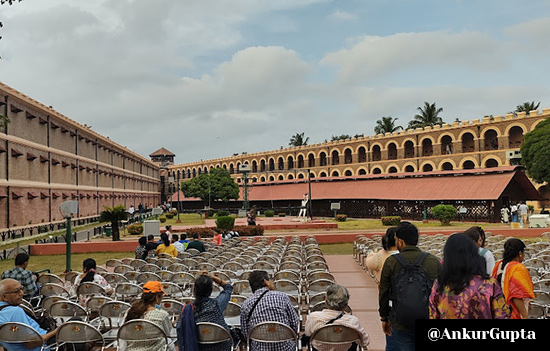 Cellular Jail Andamans. 2024.
Cellular Jail Andamans. 2024.
When fellow prisoners at Cellular Jail Andaman were disheartened he cheered them and said future generations would make a pilgrimage. Indeed, 32 years later, Netaji Bose, hoisted over Port Blair the flag of independence on 30/12/1943, honoured the memory of the Indian Revolutionaries by saluting the Cellular Jail and renamed the Andamans as ‘Shaheed Island’ in memory of the martyrs. 1 Pg. 114 Surely, Bose related to the pain of the martyrs.
On his release from
jail Bose welcomed Savarkar and urged him to join the Congress and strengthen
the national movement.
“It was an open secret that Bose, the devotee of Shivaji and his politics, had discussed the Indian political and international situation w.r.t. World War II with Savarkar, at Savarkar Sadan on 22/6/1940, six months before his dramatic disappearance from India in January 1941. In the course of the discussion Savarkar inspired Bose, with the idea of an armed revolution from outside India to intensify the struggle for Freedom.” 1 Pg. 260
Ras Behari Bose, who was the guide and sole advisor of the Azad Hind Government of Bose, was in correspondence with Savarkar till the outbreak of World War II.” 1 Pg. 260 (Behari Bose fled to Japan in
1915 and settled there. He was instrumental in organising the Tokyo Conference
in March 1942 where a resolution was passed to form the Indian National Army).
It appears that Bose was beginning to appreciate Savarkar’s views on some if not all matters.
“Bose said on 25/6/1944 at night on Singapore Radio: “When almost all the leaders of the Congress are decrying all the soldiers in the Indian Army as mercenaries, it is heartening to know that Savarkar is fearlessly exhorting the youth of India to join the Armed Forces. It is from such trained men which we draw soldiers of our I.N.A.” 1 Pg. 350
Bose had fundamental differences
with Gandhi so he quit the Congress. There were differences with Savarkar but
that did not prevent Bose from meeting Savarkar in 1940 or praising him in
1944.
Two individuals
need not agree on all issues, yet they can be an inspiration to and appreciate
each other. This binary approach of my way or the highway is the
Western way. The Indic way is to co-exist.
At a function in Pune in May 1952 Savarkar said that at the mention of Bose’s name the Congressmen got nervous, and felt inferiority complex because the courage and sacrifice of Bose. 1 Pg. 446
Scholar and patriot Dr
Gokulchand Narang, who had witnessed the first function in 1907 in London performed
by the revolutionaries of Abhinava Bharat, said that it was Savarkar who gave
the unique idea of armed revolution to the nation. 1 Pg. 502
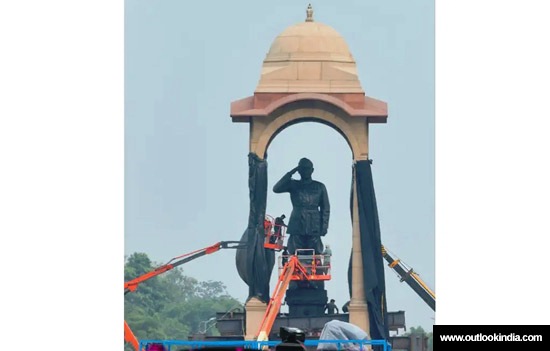 Netaji Bose statue at India Gate, New Delhi.
Netaji Bose statue at India Gate, New Delhi.
The Red Fort Trial of I.N.A. officers aroused sympathy across India. It gave a shock to the British and was one of the factors that contributed to their decision to leave India. So I.N.A. did not fight in vain. Their leader Netaji Bose has secured a permanent place of honour in India’s history.
Why did
Savarkar urge Hindus to join the British Indian Army?
Those from the Northwest helped the British suppress the 1857 Mutiny in
which the Bengal Army was
involved. The Bengal army was replaced by a Punjabized army. Table 1 shows how
the British changed the composition of the Indian Army between 1914 and
1930.
Table 1 - Changes in the Communal Composition of the Indian Army#
|
No
|
Area &
Communities
|
% in 1914
|
% in 1930
|
|
1.
|
Punjab, NW.F.P
& Kashmir
|
47
|
58.5
|
| |
Of which Punjabi Muslims-Pathans
|
17.3
|
28.95
|
| |
Of which Sikhs
|
19.2
|
13.58
|
|
2.
|
Nepal. Kumaon-Garwhal
|
15
|
22
|
|
3.
|
Upper India
|
22
|
11
|
| |
Of which Hindustani Muslims
|
4.1
|
0
|
|
4.
|
South India
|
16
|
5.5
|
|
5.
|
Burma
|
0
|
3
|
# Thoughts on Pakistan Pg. 75
The British believed that a Muslim
dominated army would counter the forces of Hindu agitation for wrestling
political power from the British.2
Pg. 89
One of the reasons Ambedkar gave for
Partition was that revenues earned from Hindustan were going to pay for a
British Army dominated by Muslims.
Savarkar knew that Hindus in the Army had to be aroused so they rebelled against British Rule. And two, Hindus could not be secure in independent India if the Indian Army was Muslim dominated (this refers to undivided India then).
Savarkar lived, from 1883 to 1966, through a crucial part of India’s history. He is yet to get his due though!
I am happy to stand
corrected. Please write with errors and reference document.
Also read
1 Did Ahimsa get Indian freedom?
2. How INA contributed to India’s Independence
3. Life Story of Savarkar
4. Why Akhand Bharat is a bad idea
5. When Marathas
and Sikhs threw out the Afghans
6. About Khudiram
Bose
7. About Bhagat
Singh
8. Veer Savarkar
has yet not been given his due
9. Meaning of
Secularism
Reference
1. Veer Savarkar by D
Keer
2. Thoughts
on Pakistan by Dr B R Ambedkar
3. History and Culture of Indian People
Volume 11 published by Bharatiya Vidya Bhawan.